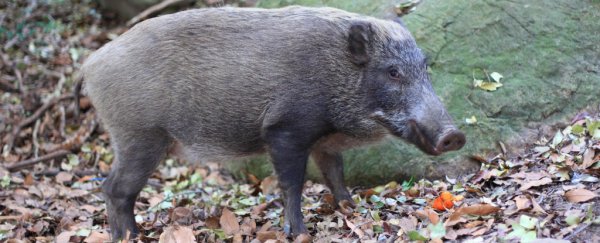From mutated insects and broken-down rescue robots, to cobweb-infested schools that haven't been touched in years, the Fukushima evacuation zone - the site of one of the worst disasters of the 21st century - is showing no signs of regaining even a semblance of habitability… for humans, at least.
Wild boars are reportedly thriving in the evacuated areas around the Fukushima Daiichi Nuclear Power Plant, which experienced multiple meltdowns following an earthquake-triggered tsunami back in 2011. And now they're tearing through nearby farmlands, causing more than US$900,000 (¥98 million) in crop damage for local farmers.
How did things get so bad? Well, under normal circumstances, this boar population would be kept under control by local hunters, with The Japan Times calling pork - including wild boar meat - "the nation's most popular meat".
But the problem is these wild boars have been contaminated with caesium-137 - a radioactive substance with a half-life of 30 years - from eating plants and small animals around the exclusion zone, and now the hunters won't go near them.
"Wild boar, along with raccoon, have been taking advantage of the evacuation zone, entering vacant houses in areas damaged by the [disaster], and using them as breeding places or burrows," assistant ecology professor Okuda Keitokunin at the Fukushima University Environmental Radioactivity Institute told the local press.
Now reproducing with abandon in the exclusion zones, the wild boar population has increased 300 percent since the disaster, from around 3,000 to 13,000, and they're spilling out into the nearby farms to tear up and trample the crops.
And local authorities are running out of ideas for how to contain the rampaging force of radioactive boars, as Travis Andrews at The Washington Post reports:
"These animals are unfit for human consumption, which presents another problem: hunters can attempt to reduce the population, but they have to do something with the carcasses. According to Texas A&M wildlife and fisheries professor Billy Higginbotham, the average size of a male hog is around 200 pounds (90 kg).
Considering this average, if 13,000 are killed, hunters have around 2,600,000 pounds (1,179,340 kg) of potentially dangerous flesh requiring disposal."
The hunters have been dumping the radioactive boar carcasses in three designated mass graves in the nearby city of Nihonmatsu, but they're only big enough to hold about 600 of these sizeable creatures, and they're filling up fast.
"Sooner or later, we're going to have to ask local people to give us their land to use," Tsuneo Saito, a local boar hunter, told The Sunday Times. "The city doesn't own land which isn't occupied by houses."
The most logical solution once these mass graves are filled to the brim is incinerating the rest of the radioactive carcasses, but you can't just burn contaminated flesh - you need a special facility that's capable of filtering out the radioactive materials so they're not redistributed across the land via smoke particles.
Andrews reports that a facility like this exists in the nearby city of Soma, but "it can only handle three boars a day (or 21 a week, which is only 1,092 each year; not quite 13,000)," he says.
So far, this is as close to a solution as the local farmers, hunters, and authorities have been able to get.
While nuclear meltdowns are tragic events for us humans, leading to a loss of life, homes, and livelihoods for so many people, many species of wildlife have shown incredible resilience in places humans fear to tread.
As we reported back in October, populations of elks, deer, wolves, bears, lynx, and boars are thriving in the Chernobyl exclusion zone decades after the devastating meltdown, simply due to a lack of human interference. Sarah Kaplan reported for The Washington Post that some of these populations have more than doubled in recent years.
"That wildlife started increasing when humans abandoned the area in 1986 is not earth-shattering news," radio-ecology expert Tom Hinton from Fukushima University told her. "What's surprising here was the life was able to increase even in an area that is among the most radioactively contaminated in the world."
Meanwhile, radioactive boars aren't the only thing local authorities in Fukushima are having to deal with. There's a whole lot of contaminated water still leaking out of the power plant, and no one's quite sure how to get rid of the radioactive tritium they're extracting from it.
One thing's for sure - humanity has never seen a disaster quite like this, and we've still got many years to go before this nightmare is over for the people trying to live in the area. All we can do is hope that science can come through with some answers.
